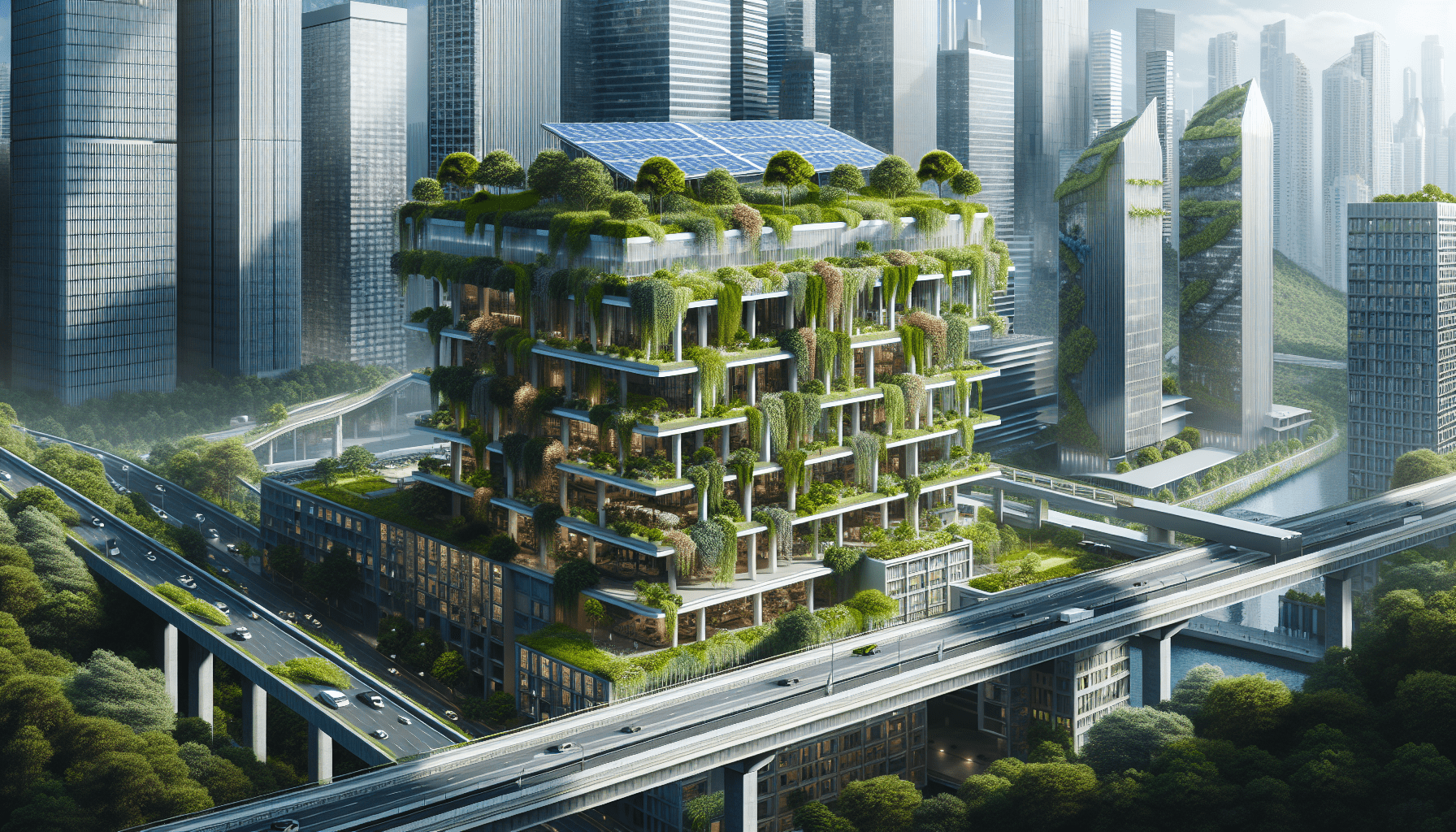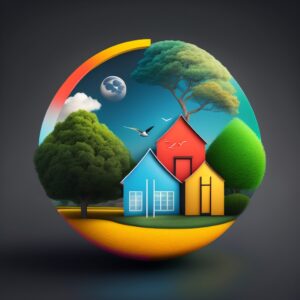In today’s world, sustainable architecture is more than just a buzzword; it’s a movement that defines how we think about building design and urban planning. At the heart of this transformation are innovative trends that focus on energy efficiency, renewable resources, and eco-friendly materials. As we explore these exciting developments, we find ourselves looking at designs that prioritize the health of our planet while enhancing our quality of life. From green rooftops to smart building technologies, sustainable architecture not only reduces our carbon footprint but also creates spaces that are adaptable, resilient, and inspiring. Our journey into the trends in sustainable architecture begins here, as we delve into the innovative solutions shaping the future of our built environment. Have you ever wondered what the trends in sustainable architecture are? As our world increasingly prioritizes environmental responsibility, the field of architecture is evolving rapidly to meet these new demands. Together, let’s explore the latest trends in sustainable architecture, looking closely at how they shape our built environment and how they contribute to a healthier planet.
Understanding Sustainable Architecture
Sustainable architecture isn’t just about using eco-friendly materials or adding a few solar panels to a building. It’s a holistic approach that considers the entire lifecycle of a building, from the initial design and construction to its eventual demolition or repurposing. By focusing on reducing environmental impact and enhancing the wellbeing of occupants, sustainable architecture aims to create spaces that harmonize with the natural world.
Core Principles of Sustainable Architecture
To truly appreciate the trends in sustainable architecture, we should first understand its core principles. Here’s a quick breakdown:
- Energy Efficiency: Designing buildings that use less energy for heating, cooling, lighting, and other functions.
- Resource Efficiency: Utilizing sustainable materials and minimizing waste.
- Water Efficiency: Implementing systems that reduce water usage and promote recycling.
- Sustainable Site Design: Considering location and orientation to minimize impact on the environment and maximize natural benefits.
- Indoor Environmental Quality: Ensuring a safe, healthy, and comfortable indoor environment.
Recent Trends in Sustainable Architecture
Now that we have a foundation, let’s dive into some of the latest trends in sustainable architecture. These trends reflect a growing awareness of our responsibility to the planet and a drive to innovate in ways that make our buildings smarter, healthier, and more sustainable.
Zero-Energy Buildings
One of the most significant trends is the push toward Zero-Energy Buildings (ZEBs). These are structures that produce as much energy as they consume, primarily through renewable energy sources like solar or wind. By balancing energy consumption with production, ZEBs significantly reduce their carbon footprints.
Features of ZEBs:
- Extensive use of renewable energy sources.
- High-performance insulation and windows.
- Advanced HVAC systems designed for efficiency.
- Smart home technologies to monitor and manage energy use.
Green Roofs and Walls
Green roofs and walls are gaining popularity for their ability to improve air quality, manage stormwater, and provide insulation. They also create green spaces in urban areas, contributing to biodiversity and enhancing residents’ mental wellbeing.
Benefits of Green Roofs and Walls:
- Reduced energy costs due to better insulation.
- Mitigation of the urban heat island effect.
- Enhanced aesthetic appeal and property value.
- Natural habitats for wildlife.
Passive House Design
The Passive House standard is another critical trend. It focuses on creating buildings that require minimal energy for heating and cooling by maximizing natural ventilation and insulation. This results in exceptionally energy-efficient and comfortable living spaces.
Key Aspects of Passive House Design:
- Superior insulation.
- Airtight construction.
- High-performance windows.
- Mechanical ventilation with heat recovery.
Adaptive Reuse of Buildings
Repurposing older buildings for new uses, known as adaptive reuse, is becoming more common. This approach reduces the waste and environmental impact associated with demolition and new construction. It also preserves historical and cultural heritage.
Advantages of Adaptive Reuse:
- Conservation of resources by utilizing existing structures.
- Reduction of construction waste.
- Preservation of historical architecture.
- Potentially lower costs compared to new construction.
Biophilic Design
Biophilic design emphasizes the integration of natural elements into built environments to improve wellbeing and productivity. This human-centric approach fosters a stronger connection to nature, even in urban settings.
Elements of Biophilic Design:
- Use of natural materials like wood and stone.
- Incorporation of plants and green spaces.
- Access to natural light and views of nature.
- Water features and natural ventilation.
Sustainable Materials
Sourcing and utilizing sustainable materials are crucial aspects of sustainable architecture. The trend towards using materials with low environmental impacts, such as reclaimed wood, recycled metals, and sustainable concrete, is growing.
Examples of Sustainable Materials:
| Material | Benefits |
|---|---|
| Reclaimed Wood | Reduces deforestation, gives new life to old wood. |
| Recycled Metal | Lowers the demand for virgin metals, reduces mining impacts. |
| Bamboo | Fast-growing, renewable, and biodegradable. |
| Hempcrete | Carbon-negative, excellent insulator. |
| Recycled Glass | Reduces waste and energy use in production. |
Smart and Green Technologies
Technological advancements in smart buildings are enhancing sustainability. These technologies allow for better energy management, improved efficiency, and increased comfort for occupants.
Green Technologies in Architecture:
- Smart Thermostats: Optimize heating and cooling systems.
- LED Lighting: Highly energy-efficient lighting solutions.
- Energy Management Systems: Monitor and control energy use.
- Water Recycling Systems: Reuse greywater and reduce potable water consumption.
Case Studies in Sustainable Architecture
To better illustrate these trends, let’s explore a few case studies of buildings that exemplify sustainable architecture principles.
The Edge, Amsterdam
The Edge in Amsterdam is often hailed as the greenest building in the world. This office building utilizes solar panels, rainwater collection, and innovative heating and cooling systems to achieve a remarkable level of sustainability.
Sustainable Features:
- Extensive use of solar energy.
- Natural ventilation and highly efficient climate control.
- Smart lighting systems that adapt to occupancy and daylight.
- Water-saving fixtures and rainwater harvesting.
Bosco Verticale, Milan
Bosco Verticale, or “Vertical Forest,” is a pair of residential towers in Milan covered with trees and shrubs. This green architecture project aims to improve air quality and biodiversity in an urban environment.
Key Highlights:
- 900 trees and over 20,000 plants integrated into building facades.
- Natural thermal and acoustic insulation.
- Enhanced biodiversity within an urban setting.
- Visual and psychological benefits for residents.
Bullitt Center, Seattle
The Bullitt Center in Seattle is a prime example of a Zero-Energy Building. Designed to operate on renewable energy, it incorporates various sustainable practices and materials to achieve its goal.
Notable Sustainable Practices:
- Roof-mounted solar panels providing all energy needs.
- Rainwater harvesting and greywater recycling.
- Composting toilets reducing water use.
- Use of non-toxic, locally sourced building materials.
The Future of Sustainable Architecture
As we continue to advance in sustainable architecture, we can expect even more innovative solutions that address global challenges like climate change, resource scarcity, and urbanization. The future of sustainable architecture will likely involve a combination of cutting-edge technology, traditional building practices, and a deep respect for the natural world.
Integrating Artificial Intelligence
Artificial Intelligence (AI) can play a significant role in sustainable architecture by optimizing building systems, predicting maintenance needs, and enhancing energy management. AI-enabled buildings can adapt to changing conditions in real-time, ensuring maximum efficiency and comfort.
Potential AI Applications:
- Predictive maintenance to extend the lifecycle of building systems.
- Automated energy management based on usage patterns.
- Climate control systems adapting to weather changes.
Circular Economy in Construction
The concept of a circular economy, where materials are reused and recycled continuously, is gaining traction in the construction industry. This approach minimizes waste and encourages the sustainable use of resources throughout a building’s lifecycle.
Circular Economy Strategies:
- Design for disassembly, allowing buildings to be easily deconstructed and materials reused.
- Use of modular construction techniques.
- Implementation of robust recycling programs for construction and demolition waste.
Embedding Resilience
As climate change leads to more extreme weather events, buildings must be designed to withstand these challenges. Resilient design focuses on creating structures that can adapt to and recover from adverse conditions, ensuring long-term durability and safety.
Resilient Design Principles:
- Elevated structures in flood-prone areas.
- Use of materials and construction techniques to withstand high winds and seismic activity.
- Incorporation of flexible spaces that can adapt to changing needs and conditions.
Community-Centered Design
Future sustainable architecture will likely emphasize community-centered design, creating spaces that foster social interaction, inclusivity, and well-being. By prioritizing the needs and preferences of communities, architects can create environments where people thrive.
Elements of Community-Centered Design:
- Public spaces that encourage social interaction and community activities.
- Mixed-use developments integrating residential, commercial, and recreational areas.
- Affordable and adaptable housing solutions.
Challenges and Opportunities
While the trends in sustainable architecture offer exciting opportunities, they also present challenges that need to be addressed by architects, builders, policymakers, and communities.
Financial Considerations
One of the primary challenges in sustainable architecture is the cost. Sustainable materials, technologies, and systems can be more expensive upfront. However, they often result in long-term savings through reduced energy and maintenance costs. Financial incentives, subsidies, and green certifications can also help offset initial expenses.
Regulatory and Policy Support
Supportive regulations and policies are crucial for promoting sustainable architecture. Governments and organizations must establish standards, provide incentives, and enforce compliance to encourage widespread adoption of sustainable practices.
Education and Awareness
Raising awareness about the benefits of sustainable architecture is essential. Educating architects, builders, and the general public can drive demand for sustainable buildings and foster a culture of environmental responsibility.
Technological Integration
Successfully integrating new technologies into sustainable architecture requires careful planning and expertise. Ensuring these technologies are user-friendly and reliable is vital for their effectiveness and widespread adoption.
Towards a Sustainable Future
As we move towards a more sustainable future, the role of architecture in shaping our built environment cannot be overstated. By embracing the trends in sustainable architecture, we can create spaces that not only meet our needs but also protect and enhance the natural world.
Encouraging Collaboration
Collaboration between architects, engineers, urban planners, and stakeholders is key to advancing sustainable architecture. By working together, we can develop innovative solutions that address environmental challenges and improve the quality of life for communities worldwide.
Continuing Innovation
The future of sustainable architecture lies in continuous innovation. By exploring new materials, technologies, and design approaches, we can push the boundaries of what is possible and create buildings that are truly sustainable and resilient.
Making Informed Choices
As consumers and community members, we have the power to support sustainable architecture through our choices. By prioritizing sustainability in our living and working environments, we can drive demand for green buildings and contribute to a healthier planet.
In conclusion, sustainable architecture is more than a trend; it is a movement towards a better, more responsible way of building. By embracing the principles and practices of sustainable architecture, we can create spaces that are not only beautiful and functional but also kind to our planet and future generations. Let’s continue to explore, innovate, and build a world where sustainability is at the heart of everything we do.




